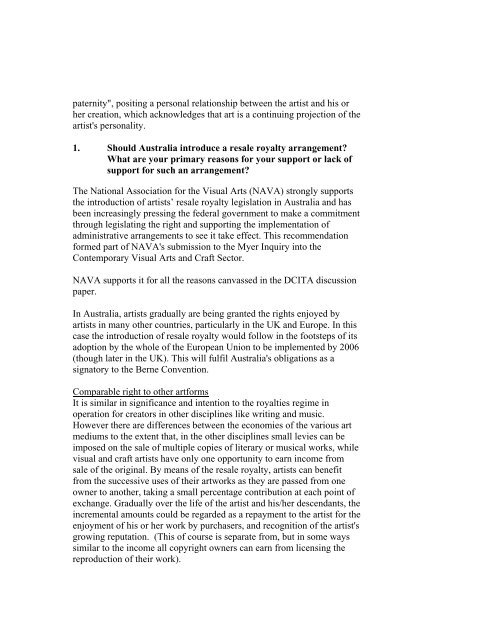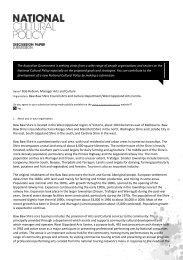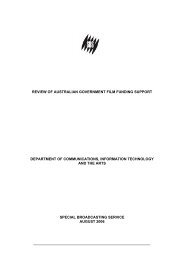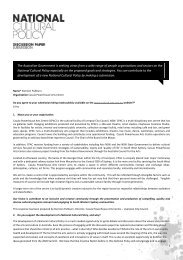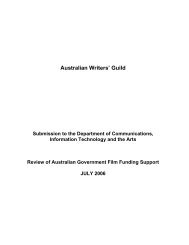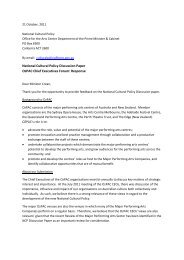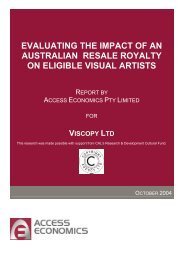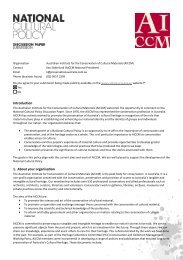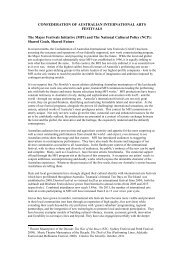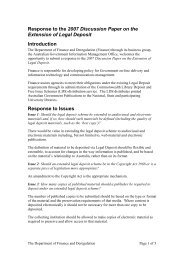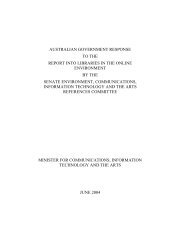National Association for the Visual Arts
National Association for the Visual Arts
National Association for the Visual Arts
You also want an ePaper? Increase the reach of your titles
YUMPU automatically turns print PDFs into web optimized ePapers that Google loves.
paternity", positing a personal relationship between <strong>the</strong> artist and his orher creation, which acknowledges that art is a continuing projection of <strong>the</strong>artist's personality.1. Should Australia introduce a resale royalty arrangement?What are your primary reasons <strong>for</strong> your support or lack ofsupport <strong>for</strong> such an arrangement?The <strong>National</strong> <strong>Association</strong> <strong>for</strong> <strong>the</strong> <strong>Visual</strong> <strong>Arts</strong> (NAVA) strongly supports<strong>the</strong> introduction of artists’ resale royalty legislation in Australia and hasbeen increasingly pressing <strong>the</strong> federal government to make a commitmentthrough legislating <strong>the</strong> right and supporting <strong>the</strong> implementation ofadministrative arrangements to see it take effect. This recommendation<strong>for</strong>med part of NAVA's submission to <strong>the</strong> Myer Inquiry into <strong>the</strong>Contemporary <strong>Visual</strong> <strong>Arts</strong> and Craft Sector.NAVA supports it <strong>for</strong> all <strong>the</strong> reasons canvassed in <strong>the</strong> DCITA discussionpaper.In Australia, artists gradually are being granted <strong>the</strong> rights enjoyed byartists in many o<strong>the</strong>r countries, particularly in <strong>the</strong> UK and Europe. In thiscase <strong>the</strong> introduction of resale royalty would follow in <strong>the</strong> footsteps of itsadoption by <strong>the</strong> whole of <strong>the</strong> European Union to be implemented by 2006(though later in <strong>the</strong> UK). This will fulfil Australia's obligations as asignatory to <strong>the</strong> Berne Convention.Comparable right to o<strong>the</strong>r art<strong>for</strong>msIt is similar in significance and intention to <strong>the</strong> royalties regime inoperation <strong>for</strong> creators in o<strong>the</strong>r disciplines like writing and music.However <strong>the</strong>re are differences between <strong>the</strong> economies of <strong>the</strong> various artmediums to <strong>the</strong> extent that, in <strong>the</strong> o<strong>the</strong>r disciplines small levies can beimposed on <strong>the</strong> sale of multiple copies of literary or musical works, whilevisual and craft artists have only one opportunity to earn income fromsale of <strong>the</strong> original. By means of <strong>the</strong> resale royalty, artists can benefitfrom <strong>the</strong> successive uses of <strong>the</strong>ir artworks as <strong>the</strong>y are passed from oneowner to ano<strong>the</strong>r, taking a small percentage contribution at each point ofexchange. Gradually over <strong>the</strong> life of <strong>the</strong> artist and his/her descendants, <strong>the</strong>incremental amounts could be regarded as a repayment to <strong>the</strong> artist <strong>for</strong> <strong>the</strong>enjoyment of his or her work by purchasers, and recognition of <strong>the</strong> artist'sgrowing reputation. (This of course is separate from, but in some wayssimilar to <strong>the</strong> income all copyright owners can earn from licensing <strong>the</strong>reproduction of <strong>the</strong>ir work).


